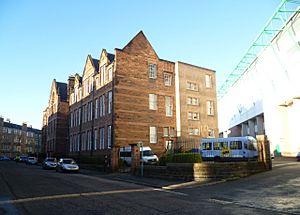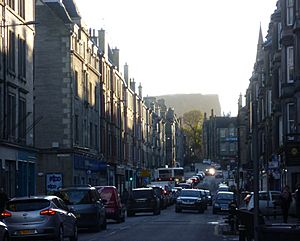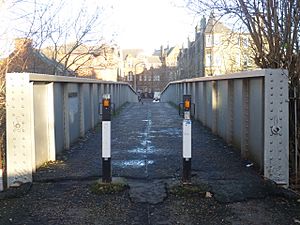The Singing Street facts for kids
"The Singing Street" is a short film made in Edinburgh, Scotland, in 1950. It was first shown in 1951. A group of teachers from Norton Park School created the film. They recorded their students playing street games and singing traditional children's songs. The filming took place in different parts of Edinburgh. This movie captured old traditions that have mostly disappeared over the years.
Contents
Making the Film

Norton Park was a school for younger teenagers, similar to a "Secondary Modern School" in England. The school building is still there today, right next to the Easter Road football stadium. It's now a business center. When the film was made, the area around the school was very industrial. There were factories and printing works, surrounded by apartment buildings.
The teachers who made the film were very dedicated. James T.R. Ritchie, a science teacher, collected all the songs. His art teacher friends, Nigel McIsaac and Raymond Townsend, helped him. Nigel McIsaac drew rough storyboards to plan the shots. William Geissler and Raymond Townsend operated the camera. The songs were recorded after the filming and then added to the movie. A Scottish poet named Norman McCaig even provided the whistling for the soundtrack! The teachers did all the filming, cutting, and editing themselves. They also got advice from groups like the Scottish Film Council.
The film is in black and white and lasts 18 minutes. Its main goal was to show how children played singing games in their natural surroundings, from morning until dusk. About 60 students, aged 11 to 14, were in the film. They filmed during the school's Easter holiday in 1950. Locations included streets and shared drying areas near Easter Road, and other famous Edinburgh spots like Calton Hill and the Canongate.
Children's Games and Songs
The games in the film often involve themes of love and loss. The rhymes were passed down through generations by word of mouth. Notes from a 1993 video release of the film explain that these rhymes changed from street to street and day to day. Old songs stayed alive, but new ones also appeared. The children just accepted the words and kept the poetry going without questioning their meaning. The songs in the film are sung while children play skipping and ball games.
The film's subtitle is A Merry-Ma Tanzie. This is a traditional Scottish wedding game, sung to the same tune as Here we go round the Mulberry Bush. In this game, girls hold hands in a circle and fall to the ground at a certain point. One girl, often chosen for being slow to fall, leaves the circle. She tells a close friend the name of the person she wants to marry. The other girls sing verses to guess the name. Once the name is approved, the girl and her friend (as a "bridal couple") are welcomed back into the circle. They pass through "high arches" made by the other girls' arms and kiss. This game was first mentioned in a magazine in Edinburgh in 1821.
The film captured a moment in children's history just before playing in the street became less common. This happened as more people got televisions in Britain. However, the games seen in the film continued to be played in school playgrounds through the 1950s and 1960s. In the 1950s, Edinburgh's city council even made many inner-city streets "children's play areas." They asked drivers to avoid these streets from the end of the school day until sunset.
James Ritchie, one of the teachers, noted that old city areas, with their mix of homes and factories, created exciting places for children to play. He felt that new buildings often lacked these "Unknown Corners" that made playing so fun.
Film's Impact
"The Singing Street" received great praise when it was shown at the UNICA Festival in Barcelona in 1952. John Grierson, who is known as the "father of the documentary," said it was "the best amateur film I ever saw." He added that it was wonderful because "Somebody loved something and conveyed it."
James Ritchie later wrote two short books about children's songs: The Singing Street (1964) and Golden City (1965). In Golden City, he explained how he first became interested in children's games:
One morning in Norton Park School, I was teaching science... I asked, "Then what do you like doing?" The class answered: "We like playing games." "What games?" They told me, and I began then and there to write them down. From then on I collected every sort of rhyme or playing jingle, and my collection grew.
A famous American folk-song collector named Alan Lomax also recorded the Norton Park students. He visited Scotland in 1951, 1953, and 1957. These recordings can be heard on a CD called Singing in the Streets: Scottish Children’s Songs. Lomax's work helped inspire the creation of the School of Scottish Studies at Edinburgh University in 1951.
In one scene, a man wearing a hat and gloves, holding a walking stick, watches a group of boys singing. This was Pat Murray, an Edinburgh Councillor. He loved collecting children's toys and was key to starting Edinburgh's Museum of Childhood. It opened in 1955 and is now a popular tourist attraction on the city's Royal Mile.
Songs Featured in the Film
- The Golden City
- Weary, weary, waiting on you
- Down to the baker's shop
- Sweet Jenny
- On the Mountain
- The Bluebird
- Bluebells and dummie shells
- O alla tinka
- Little sandy girl
- Three Jews from Spain
- The bonny bunch of roses
- The Dusting Bluebells
- The Golden City
- When I was single
- Up and down
- Plainie, clappie
- I Sent Her For Butter
- Down in the valley
- Orphan girl
- The night was dark
- I once had a boy
- Broken-hearted I wandered
Images for kids




